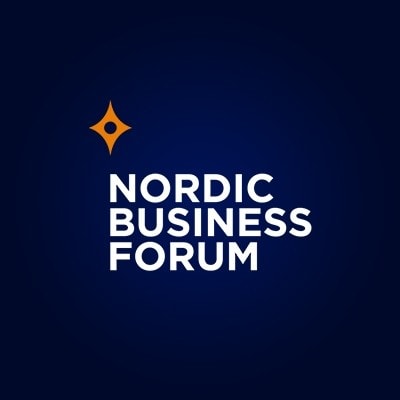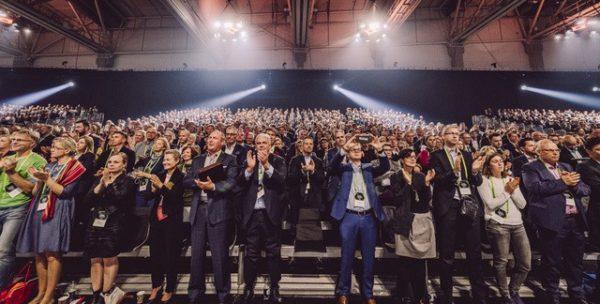15Dec2017
To continue our NBFSweden 2018 Speaker Spotlight series, we warmly welcome Anita Krohn Traaseth!
Anita Krohn Traaseth is an author the CEO of Innovation Norway. She enjoys a high profile on the Norwegian business scene and has held many board memberships. An accomplished communicator, Krohn Traaseth published her first book in 2014, Good Enough for the Bastards (Godt nok for de svina), which went on to become a local bestseller. We sat down with her to discuss her upcoming appearances at Nordic Business Forum Sweden and Norway 2018.
Nordic Business Forum: Hi Anita. Thanks for joining us today. Let’s start by talking about your upcoming presentations at NBFSweden and NBFNorway 2018: Could you give us a sneak preview of what we can expect to see?
Anita Krohn Traaseth: You can expect to hear about perspectives and experiences on leadership in times of transition of the economy to the post-oil era. I’ll touch on the role of the public sector, transformation, success, and failure, and use Innovation Norway as a practical case since it is the Norwegian Government’s most important instrument for innovation and development of Norwegian enterprises and industry.
NBF: As your topic suggests, the times are a-changing in the world of business leadership. In your experience, what are the characteristics of effective leaders?
AKT: That’s a complex answer… To be an effective leader, leading complex transformations, there are no easy answers to a universal or perfect description of a leader-profile.
Being effective in times of change demands perspective and a healthy balance between speed, respect, and realism around processes and relations to make changes happen. It demands the ability to understand and respect the task, seeking the big picture and not underestimating the landscape they need to navigate. Effective leaders continuously seek perspective and advice to lead as the circumstances and surroundings are constantly changing specifically in transformations.
Strong curiosity, focus, and time spent on understanding and meeting customers, getting to know employees, their culture and anchor processes of change are also important characteristics of effective leaders. The ability to balance, when to stop, reverse, or push processes when needed is key to being effective over time. It’s important that they are constantly striving to improve themselves and the organization, and never believing they have all insights needed. They should also celebrate wins and progress.
Being authentic, transparent, and available is also important. Focus on developing and empowering employees, mobilize stakeholders by sharing information, inviting new partnerships and always seek new constellations for cooperations. Effective leaders should always seek to improve efficient and simple communication, listening and valuing feedback. Be a Gordian knot in changing times.
Most importantly, be open and personal when times are challenging, but leave no doubt that you all will manage and overcome challenges and move to next phase.
NBF: Wonderful! You’re right, that’s a layered topic. Since Lead Lean is the conference theme, how can Lean methodology be applied to leadership as opposed to manufacturing or sales?
AKT: Let’s start by looking at what distinguishes Lean methodology in leadership from using the Lean principles in production and sales. It might also be fruitful to distinguish between traditional Lean, known through the Toyota Production Systems (TPS) and the Lean Startup that was popularized through the books of Eric Ries.
Traditional Lean, the way we know it through TPS, is usually well rooted in the management of companies. TPS is often about the Japanese term Kaizen or “continuous improvement” of the process of creating more value with less waste. We talk more about optimizing the existing value chain internally, but also externally. Continuous improvement is therefore well suited where the market and technology are known – this is where incremental improvements are enough to keep up the competitors.
But as soon as the top management of companies must relate to new markets or disruptive technologies – as most of us actually have today – then there is a need of an additional mindset to the Kaizen and a continuous improvement ideology. This is because you then are looking into a new and unknown “business terrain” with lots of white spots and enhancing risk. Based on my experience, it’s when navigating in this hazy terrain that the Lean Startup and its principles really works well. Then, it is all about working on evidence-based practice through early systematically testing needs and solutions in the market, in close dialogue with customers outside our own office buildings.
Having these two different mindsets in mind, the challenge for top management is to “ride two horses” – at the same time. If we are to stay within the world of animals, traditional Lean, like Kaizen, is about taking care of the company’s “Cash Cow” in the best possible way, to ensure that it receives the resources needed and that the surrounding conditions are as optimal as possible. It’s about milking the Cow as best as you can – and for as long as you can. But as mentioned, while management focuses on optimal operation and minimal waste of resources, we also have to look for what is going to be the company’s next Cash Cow, since both cows and business models expire. In this search process for new business opportunities, we still need to minimize waste and develop solutions in close dialogue with the customers and the real owner of the needs.
Innovation Norway is not a traditional company that sells products or services directly to customers, but we are facing the same type of dilemma associated with optimizing the operation of managing taxpayers’ money in the most efficient way, and at the same time relate to a global business landscape in constant and fast change. In order to be relevant to both our governmental departments and municipality owners, we need to manage this dual processes in an ambidextrous manner.
NBF: Thank you for clarifying and explaining these concepts. It seems like an interesting task to implement Lean principles at Innovation Norway. What does Lean leadership look like for you, practically?
AKT: Does IN have an organization influenced by Lean leadership? Yes, we are inspired by the traditional Lean models and we implement step by step a culture to be less organizational-oriented to become more customer-oriented. In TPS, or in the Lean Toyota way, the principle of “Genchi Genbutsu” is important that both management and employees go into the field and see themselves.
Our process of “speed dating” more than 600 employees, opening up the leadership meetings for direct feedback from customers, mobilizing the Dream Commitment process, where over 80 different arrangements were held all over Norway and globally to get input on where the Norwegian industries and start-ups points out the new direction for Norwegian business, as a base for our new strategy, could be relevant as examples of Lean in practice. How we design and operate the digitization projects of Innovation Norway could also be relevant here.
NBF: How do you predict leadership in business will look in the future? Will “Lean” leadership make the transition from trend to tradition?
AKT: It’s possible that many will perceive Lean as a trend that will “fade out”. I doubt it, though, for, as I once said; “Lean did not start with the Toyota Company but as a result of Henry Ford’s assembly line in the 19 twenties.” So, we are actually looking at a long industrial tradition that has evolved, and especially since the 2000’s.
In many ways, I think we can conclude that Lean leadership is actually more a necessity and not a transient trend. In this context, it may be mentioned that perhaps the most important principle in Lean ‘No Muda’ or ‘no trash’ will hardly be outdated in the coming decades. This is also the basis for the circular economy, which is gaining more and more momentum in business internationally. These holistic ways of seeing business – with zero waste as guiding principles – will be on the rise in the future.
NBF: Great! And now, before we finish up, tell us… If people reading this interview learn only one thing from you, what should it be?
AKT: That Lean is as relevant for complex organizations in the public sector as it is for the private sector and start-ups. That effective leaders understand the difference and new links between achieving classical productivity goals and long-term sustainable effects.
One of the most important tasks of today’s (and tomorrow’s) leaders’ is to build organizational cultures where learning is in focus. Not as a goal, but as a guiding principle for how we operate. This implies, among other things, that failing is not just something that is okay, but an absolute prerequisite for progression.
We’re excited to learn more from Anita Krohn Traaseth at NBFNorway and NBFSweden 2018! If you’d like to hear her and other leaders discuss this year’s theme of lean leadership, be sure to grab your ticket or Live Stream license today. Follow us on Facebook and Twitter and #NBFSweden to keep up with our speaker announcements as we get closer to the event!

 by:
by: 
